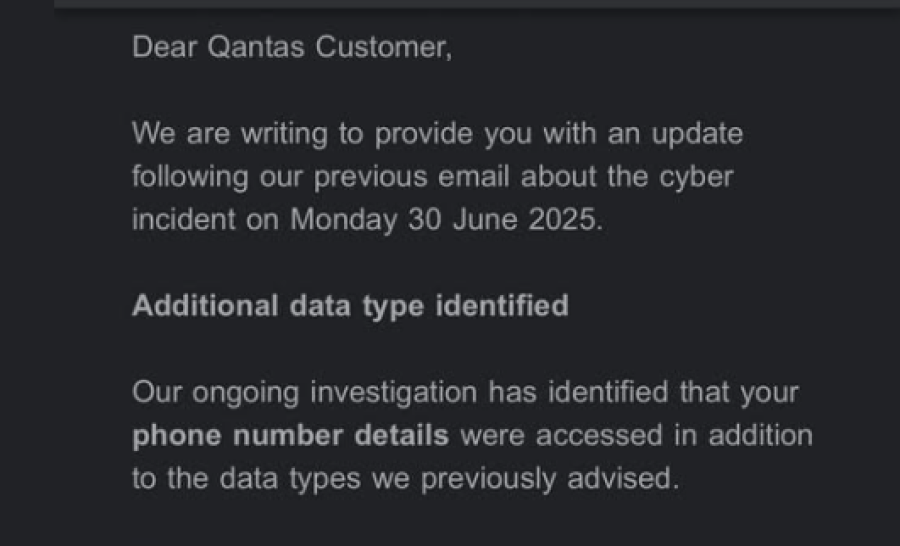Top Scams: Qantas Data Leak, Fake Barclays Email, and Jewelry Site Warning

Author: Adam Collins
Scammers are no longer hiding behind broken English and shady pop-ups. Today’s cons are clean, professional, and sometimes even poetic. They name-drop banks, sound like airlines, and offer handcrafted jewelry so perfect it practically glows. Their secret weapon? Emotion — fear, urgency, excitement. And once they’ve hooked your feelings, they go for your details.
This week, we’re unpacking four trending scams that are smooth, sharp, and sadly effective. From cyber incidents at Qantas to a suspiciously charming jewelry store that seems too polished to be real, here’s what to know and how to stay safe.
Qantas Data Breach: The “Surprise, We Lost Your Number Too” Incident
The Setup:
Qantas customers received a follow-up email this week with an ominous subject line: “Additional data type identified.” Translation? Your phone number was also in the data breach during the June 30 cyber incident. If you’re a Qantas Frequent Flyer, your personal info might now be floating around in scammers' inboxes.

Source: Facebook
The message urges customers to stay alert for phone-based scams, not just phishing emails or dodgy texts. In short, scam calls might be coming to a number you thought was safe.
What’s Sketchy:
- This is real — and that’s what makes it so dangerous.
- Scammers love piggybacking on real breaches to launch fake follow-ups.
- Now that your number is exposed, expect more cold calls pretending to be Qantas, your bank, or someone pretending to “help.”
Pro Tips:
- Be wary of unexpected calls claiming to be from Qantas or any authority.
- Never give out personal or payment details over the phone unless you initiated the call
- Bookmark official support pages — if you’re unsure, hang up and contact the company directly.
- Use ScamAdviser.com to check suspicious domains or phone numbers.
Barclays Biometric Scam: When the Link Isn’t as Smart as Your Face ID
The Setup:
You receive an email from Barclays, complete with your name in the greeting and a very official tone. The message says that, due to new FCA requirements, all customers must activate biometric login — fingerprint or face scan — immediately. There’s even a tidy little button that says “Get Started.”
It feels modern. Secure. Mandatory. But it’s none of the above.

What’s Sketchy:
- The FCA has no such requirement.
- Barclays isn't asking customers to sign up for biometric ID by email.
- The link goes to a phishing site — a convincing fake — where your login credentials and bank details are up for grabs.
Pro Tips:
- Don’t click links in emails asking you to “activate” anything urgently.
- Visit your bank’s website directly or call customer service.
- Biometric features are usually set up in your banking app, not through random emails.
- Look out for slightly misspelled URLs or strange email sender addresses.
“I’m Wendy Clarke”: The Jewelry Store That’s Almost Too Pretty to Be True
The Setup:
You’re scrolling social media when you stumble upon a stunning ad: minimalist, handmade, ethical jewelry crafted in Edinburgh by a woman named Wendy Clarke. The website looks dreamy. The copy reads, “Each design tells a story — maybe even yours.” Prices are surprisingly affordable. It feels personal, poetic... and just a little suspicious.

What’s Sketchy:
- The store has little-to-no customer reviews outside of its own site.
- Domain history is new or linked to scam complaints.
- Some buyers report paying but never receiving their orders, or receiving poor-quality, mass-produced knockoffs.
Pro Tips:
- Run the website through ScamAdviser.com before you buy.
- Check for an “About” page with verifiable details (address, real business registration, contact info).
- Google the brand + “scam” or “review” to see what others are saying.
- If it looks like Etsy but costs like Temu, dig deeper before you click Add to Cart.
Bonus Scam Alert: “Delivery Attempt Failed” Texts Are Back
The Setup:
You get a text saying your package couldn’t be delivered due to an address issue. There’s a link to “reschedule” or pay a small redelivery fee.
What’s Sketchy:
- You weren’t expecting a delivery.
- The tracking number is generic or nonexistent.
- The link asks for payment information and personal data.
Pro Tips:
- Check with your delivery provider directly — never click links in unsolicited texts.
- Scammers often spoof legitimate courier names like DHL, Australia Post, or FedEx.
- Use your tracking app or account to verify deliveries.
Bottom Line: Scammers Are After Your Trust, Not Just Your Info
Whether it’s an airline admitting a breach, a bank being impersonated, or a heartfelt jewelry site with suspicious sparkle, scams these days don’t always look shady. They’re crafted to feel real. To feel safe. And that’s exactly what makes them dangerous.
So here’s your survival rule:
🔍 Pause before you click.
🧠 Verify before you act.
📣 Report what’s suspicious — you might save someone else.
If you’re ever unsure, run a quick check at ScamAdviser.com or download the ScamAdviser App. It’s fast, free, and can flag dodgy sites, phone numbers, and wallets before you fall into the trap.
Because in a world full of digital danger dressed as opportunity, a little skepticism is your superpower.
Report a Scam!

Have you fallen for a hoax, bought a fake product? Report the site and warn others!
Scam Categories
Help & Info
Popular Stories
As the influence of the internet rises, so does the prevalence of online scams. There are fraudsters making all kinds of claims to trap victims online - from fake investment opportunities to online stores - and the internet allows them to operate from any part of the world with anonymity. The ability to spot online scams is an important skill to have as the virtual world is increasingly becoming a part of every facet of our lives. The below tips will help you identify the signs which can indicate that a website could be a scam. Common Sense: Too Good To Be True When looking for goods online, a great deal can be very enticing. A Gucci bag or a new iPhone for half the price? Who wouldn’t want to grab such a deal? Scammers know this too and try to take advantage of the fact. If an online deal looks too good to be true, think twice and double-check things. The easiest way to do this is to simply check out the same product at competing websites (that you trust). If the difference in prices is huge, it might be better to double-check the rest of the website. Check Out the Social Media Links Social media is a core part of ecommerce businesses these days and consumers often expect online shops to have a social media presence. Scammers know this and often insert logos of social media sites on their websites. Scratching beneath the surface often reveals this fu
So the worst has come to pass - you realise you parted with your money too fast, and the site you used was a scam - what now? Well first of all, don’t despair!! If you think you have been scammed, the first port of call when having an issue is to simply ask for a refund. This is the first and easiest step to determine whether you are dealing with a genuine company or scammers. Sadly, getting your money back from a scammer is not as simple as just asking. If you are indeed dealing with scammers, the procedure (and chance) of getting your money back varies depending on the payment method you used. PayPal Debit card/Credit card Bank transfer Wire transfer Google Pay Bitcoin PayPal If you used PayPal, you have a strong chance of getting your money back if you were scammed. On their website, you can file a dispute within 180 calendar days of your purchase. Conditions to file a dispute: The simplest situation is that you ordered from an online store and it has not arrived. In this case this is what PayPal states: "If your order never shows up and the seller can't provide proof of shipment or delivery, you'll get a full refund. It's that simple." The scammer has sent you a completely different item. For example, you ordered a PlayStation 4, but instead received only a Playstation controller. The condition of the item was misrepresented on the product page. This could be the